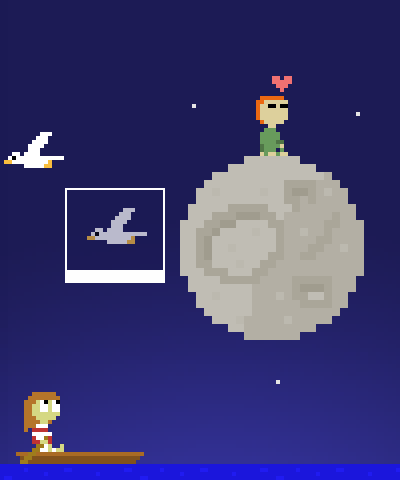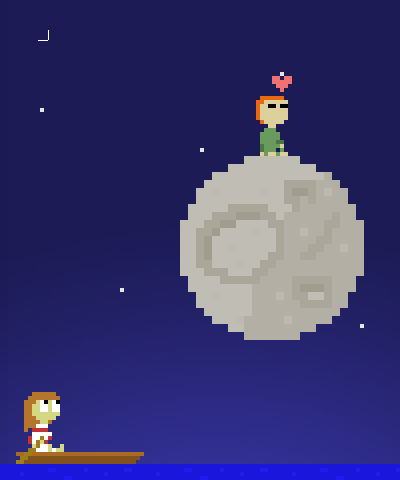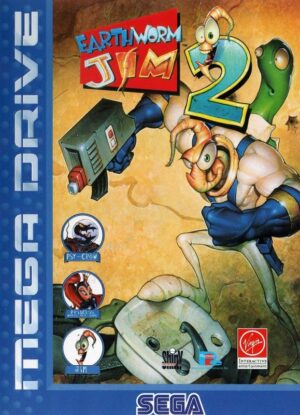Retro Replay Review
Gameplay
I Wish I Were the Moon offers a deceptively simple puzzle framework built around a single, non-scrolling scene. The player’s only tool is a virtual camera controlled by the mouse: frame an area, snap a photo, and then click to place that captured element elsewhere. It’s an elegant mechanic that merges environmental manipulation with photographic composition, encouraging experimentation rather than timed challenges or lives. Each repositioned object or character can trigger subtle reactions, opening paths to five distinct endings.
(HEY YOU!! We hope you enjoy! We try not to run ads. So basically, this is a very expensive hobby running this site. Please consider joining us for updates, forums, and more. Network w/ us to make some cash or friends while retro gaming, and you can win some free retro games for posting. Okay, carry on 👍)
Progression is entirely player-driven. There are no traditional tasks or dialogue prompts—only the silent tableau of a girl rowing a boat and a boy perched atop the moon. With each snapshot and relocation, you gradually unveil new emotional dynamics between the trio. After achieving an ending, pressing R rewinds the scene to its initial state, preserving your unlocked ending in the gallery. This rewind feature allows you to iterate rapidly, testing fresh combinations without tedium.
The puzzles aren’t about inventory or code-breaking; they’re about perception and sequencing. Some solutions hinge on spatial relations—moving the moon just close enough to touch the water, for instance—while others rely on character timing or interplay. Two additional endings and a secret conclusion were introduced in the November 2008 update (submitted for the Independent Game Festival 2009), ensuring that even returning players find new surprises.
Graphics
Visually, I Wish I Were the Moon leans into painterly silhouettes against a muted color palette. The art style evokes the dreamlike quality of both Enigma’s “Sitting on the Moon” and Calvino’s Cosmicomics tale. Subtle gradients in the sky shift as you reposition the moon, and gentle ripples appear when the moon’s reflection meets the water. These touches lend each ending a distinct mood, from serene melancholy to wistful hope.
Character models are minimalist but expressive: the girl’s rowing strokes become more urgent if you angle the moon too low, and the boy on the moon shifts his posture depending on proximity. Background flourishes—a distant star, a drifting cloud—respond to your camera movements, reinforcing that this is an emotional portrait rather than a physical landscape. The overall effect is more illustrative than photographic, perfectly aligning with the game’s metaphorical intentions.
Performance is smooth even on modest hardware. Because the scene never scrolls, load times are negligible, and frame rates remain stable. The UI is almost invisible: the crosshair for your camera and a small rewind indicator are the only on-screen elements. This minimal interface keeps you immersed in the tableau, emphasizing that the real “puzzle” lies in the emotional resonance of each captured frame.
Story
At its core, I Wish I Were the Moon is an exploration of longing and connection. Inspired by Italo Calvino’s “The Distance of the Moon” and Enigma’s poetic anthem, the narrative paints a love triangle where the moon itself vies for affection. The girl rows her boat across a placid sea, driven by desire and curiosity, while the boy balances precariously on the moon, symbolizing both distance and aspiration.
Rather than conveying plot through text or voice-over, the game’s story unfolds via juxtaposition. By moving elements within the frame, you witness fleeting moments—a hand reaching down, a gaze cast upward, or a splash that alters everything. Each ending crystallizes a different emotional outcome: reconciliation, heartbreak, union, or solitude. The secret ending, unlocked by a precise and counterintuitive sequence, feels like discovering a hidden stanza of a song.
This form of storytelling demands active engagement. You’re not watching cutscenes; you’re orchestrating them. In doing so, you forge a personal narrative where every outcome feels earned. The lack of explicit dialogue allows the themes of distance, desire, and serendipity to resonate more profoundly, as you fill in the emotional blanks with your imagination.
Overall Experience
I Wish I Were the Moon is a brief but resonant journey—one you can complete in under an hour if you’re decisive, or stretch into several sessions as you hunt down each ending. Its brevity is a strength, preventing the central mechanic from overstaying its welcome. Each new ending feels like the final verse of a hauntingly beautiful song.
Replay value is baked into the design. Discovering two new endings plus a secret conclusion after the IGF 2009 update adds depth for completionists and narrative explorers alike. The rewind function is seamless, letting you iterate without frustration, and the simple controls ensure that even players unfamiliar with puzzle games can dive in immediately.
While its minimalistic presentation may not satisfy those seeking action or sprawling worlds, fans of contemplative, art-house experiences will find it spellbinding. Its fusion of music-inspired ambiance and literary homage sets it apart from conventional indie puzzles. If you’re drawn to games that feel like visual poems—where you manipulate emotion as much as objects—I Wish I Were the Moon is an unforgettable voyage across a glassy sea under a watchful, luminous companion.
 Retro Replay Retro Replay gaming reviews, news, emulation, geek stuff and more!
Retro Replay Retro Replay gaming reviews, news, emulation, geek stuff and more!






Reviews
There are no reviews yet.